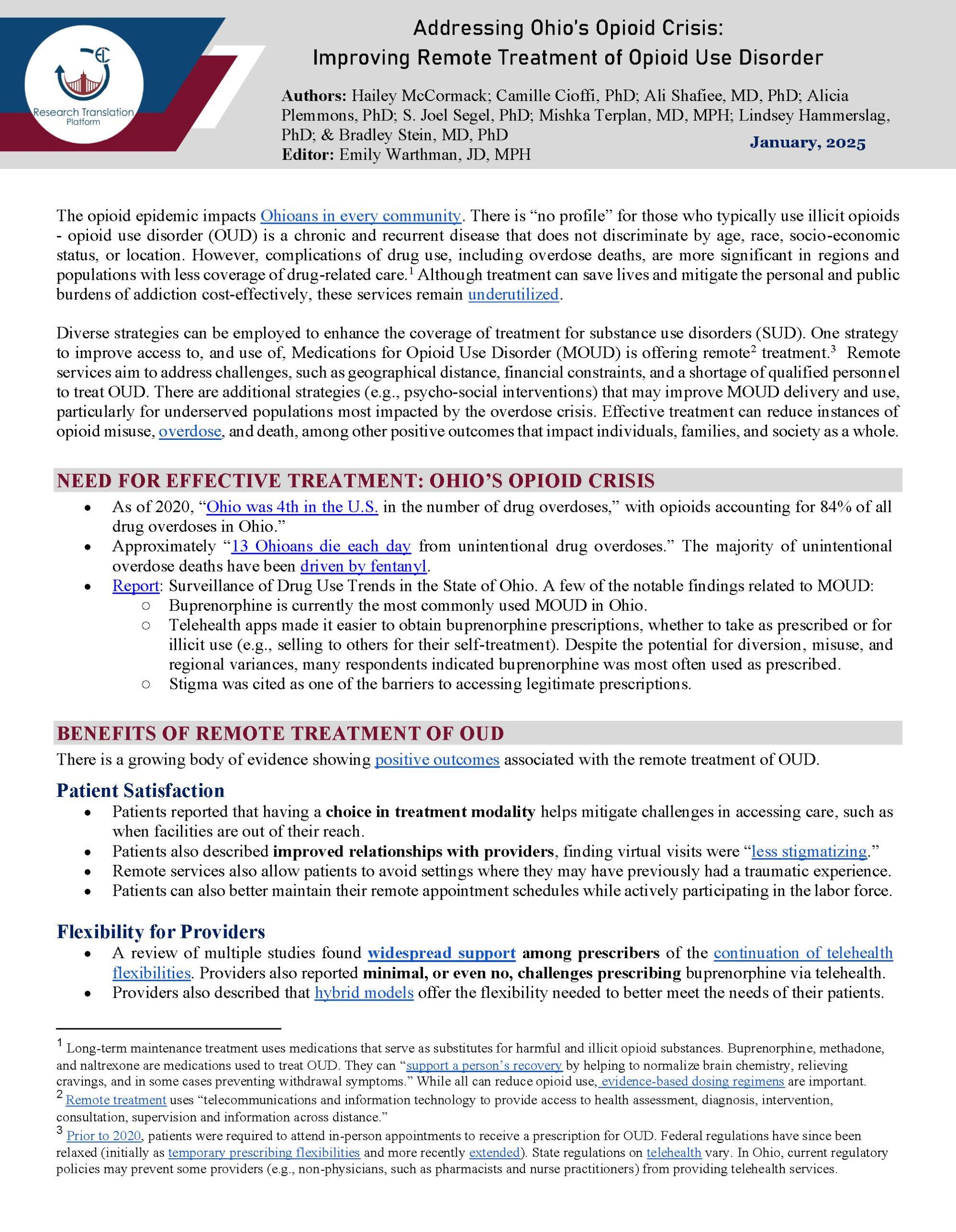
The opioid epidemic impacts Ohioans in every community. There is “no profile” for those who typically use illicit opioids – opioid use disorder (OUD) is a chronic and recurrent disease that does not discriminate by age, race, socio-economic status, or location. However, complications of drug use, including overdose deaths, are more significant in regions and populations with less coverage of drug-related care.[1] Although treatment can save lives and mitigate the personal and public burdens of addiction cost-effectively, these services remain underutilized.
Diverse strategies can be employed to enhance the coverage of treatment for substance use disorders (SUD). One strategy to improve access to, and use of, Medications for Opioid Use Disorder (MOUD) is offering remote[2] treatment.[3] Remote services aim to address challenges, such as geographical distance, financial constraints, and a shortage of qualified personnel to treat OUD. There are additional strategies (e.g., psycho-social interventions) that may improve MOUD delivery and use, particularly for underserved populations most impacted by the overdose crisis. Effective treatment can reduce instances of opioid misuse, overdose, and death, among other positive outcomes that impact individuals, families, and society as a whole.
Need For Effective Treatment: Ohio’s opioid crisis
- As of 2020, “Ohio was 4th in the U.S. in the number of drug overdoses,” with opioids accounting for 84% of all drug overdoses in Ohio.”
- Approximately “13 Ohioans die each day from unintentional drug overdoses.” The majority of unintentional overdose deaths have been driven by fentanyl.
- Report: Surveillance of Drug Use Trends in the State of Ohio. A few of the notable findings related to MOUD:
-
- Buprenorphine is currently the most commonly used MOUD in Ohio.
-
- Telehealth apps made it easier to obtain buprenorphine prescriptions, whether to take as prescribed or for illicit use (e.g., selling to others for their self-treatment). Despite the potential for diversion, misuse, and regional variances, many respondents indicated buprenorphine was most often used as prescribed.
-
- Stigma was cited as one of the barriers to accessing legitimate prescriptions.
Benefits of Remote Treatment of OUD
There is a growing body of evidence showing positive outcomes associated with the remote treatment of OUD.
Patient Satisfaction
- Patients reported that having a choice in treatment modality helps mitigate challenges in accessing care, such as when facilities are out of their reach.
- Patients also described improved relationships with providers, finding virtual visits were “less stigmatizing.”
- Remote services also allow patients to avoid settings where they may have previously had a traumatic experience.
- Patients can also better maintain their remote appointment schedules while actively participating in the labor force.
Flexibility for Providers
- A review of multiple studies found widespread support among prescribers of the continuation of telehealth flexibilities. Providers also reported minimal, or even no, challenges prescribing buprenorphine via telehealth.
- Providers also described that hybrid models offer the flexibility needed to better meet the needs of their patients.
Mitigating Barriers to Traditional Treatment
- Telehealth solutions have successfully engaged a wide variety of OUD patients who have historically faced additional barriers to accessing care, including: veterans, those with co-occurring mental health needs, individuals experiencing homelessness, justice-involved individuals, and those in rural communities, among others.
- Remote treatment bypasses the need to find transportation or childcare and minimizes time off work to attend appointments. This can be particularly important for low-income patients and those in rural communities.
Treatment Initiation & Retention
- After federal prescribing regulations were relaxed due to the COVID-19 pandemic, many patients successfully initiated MOUD remotely via telehealth and were maintained in treatment.
- Initiating buprenorphine via telemedicine has been associated with equal or higher rates of treatment retention (compared to initiating treatment via an in-person visit).
Opportunities to Address Challenges with Remote Treatment of OUD
Offering prescriptions for MOUD remotely is beneficial for those who receive it. However, telehealth solutions alone are insufficient to remove all barriers to treatment, and remote treatment may not be appropriate in all circumstances.[4] Many providers do not prescribe medications to treat OUD, despite its potential benefits. During the pandemic, older providers and those who owned an independent practice did not offer telehealth as frequently as compared to providers who were younger and practicing with others. The geographical distribution of providers and inadequate prescription supplies have made accessing treatment more challenging, especially for minority populations. Also, regulatory flexibility has primarily focused on physicians and not broad extension to other providers (e.g., pharmacists, psychologists, nurse practitioners).
The success observed in initiating treatment for individuals with OUD during the pandemic did not extend to individuals who were not yet in treatment. Underserved populations are still less likely to receive treatment for MOUD, even when offered remotely, despite a disproportionate risk for opioid overdose. Additional factors (e.g., insurance status, coverage, and payer type) can increase the financial burden for treatment. Effectively addressing these challenges can enhance coverage of treatment for OUD and improve key outcomes (e.g., health and economic, among others).
Policy Options
The following strategies are grounded in evidence-based best practices to improve access to MOUD across settings and populations, including for those facing the greatest barriers to treatment.
- Provider Education & Support. Training and technical support can enhance providers’ comfort with both prescribing MOUD and telehealth technology. A better understanding of the benefits of MOUD, technology navigation, and awareness of the harms of stigma associated with OUD is needed among more providers.
- Prescribing Flexibility. Strategies to facilitate MOUD and improve treatment coverage include:
-
- Expand prescriptive authority across provider types to mitigate workforce shortage concerns and increase prescription volume across a wider geography, along with increased treatment uptake.
-
- Empower providers with flexibility in determining the best treatment approach for individual patients (e.g., treatment modality, days’ supply per prescription, drug testing requirements).
-
- Increase availability of MOUD in inpatient and outpatient behavioral treatment settings.
- Treatment Feasibility. Multifaceted approaches can help address disparities in treatment:
-
- Relax requirements for entry into treatment (e.g., same-day services, mobile clinics), which can expand treatment availability for those in rural communities or facing socioeconomic barriers.
-
- Support initiatives, such as smartphone distribution, to help patients connect with telehealth services.
- Support initiatives, such as smartphone distribution, to help patients connect with telehealth services.
- Additional Research. Much of what we know about remote treatment of OUD stems from pandemic-related regulatory changes and practices. Additional study is needed to better understand the factors that impact treatment availability, effectiveness, and opportunities to improve health equity and treatment outcomes.
References
[1] Long-term maintenance treatment uses medications that serve as substitutes for harmful and illicit opioid substances. Buprenorphine, methadone, and naltrexone are medications used to treat OUD. They can “support a person’s recovery by helping to normalize brain chemistry, relieving cravings, and in some cases preventing withdrawal symptoms.” While all can reduce opioid use, evidence-based dosing regimens are important.
[2] Remote treatment uses “telecommunications and information technology to provide access to health assessment, diagnosis, intervention, consultation, supervision and information across distance.”
[3] Prior to 2020, patients were required to attend in-person appointments to receive a prescription for OUD. Federal regulations have since been relaxed (initially as temporary prescribing flexibilities and more recently extended). State regulations on telehealth vary. In Ohio, current regulatory policies may prevent some providers (e.g., non-physicians, such as pharmacists and nurse practitioners) from providing telehealth services.
[4] In-person visits may help some patients with social isolation or navigating the physical impacts of withdrawal. It can also help prevent complications, which is especially important when the medications are first used.
The Research-to-Policy Collaboration (RPC) works to bring together research professionals and public officials to support evidence-based policy. Please visit their website to learn more.
Key Information
RPC Website
Research-to-Policy Collaboration
Publication DateJanuary 24, 2025
Topic Area(s)Substance Use and Misuse
Resource TypeWritten Briefs
Share This Page
The opioid epidemic impacts Ohioans in every community. There is “no profile” for those who typically use illicit opioids – opioid use disorder (OUD) is a chronic and recurrent disease that does not discriminate by age, race, socio-economic status, or location. However, complications of drug use, including overdose deaths, are more significant in regions and populations with less coverage of drug-related care.[1] Although treatment can save lives and mitigate the personal and public burdens of addiction cost-effectively, these services remain underutilized.
Diverse strategies can be employed to enhance the coverage of treatment for substance use disorders (SUD). One strategy to improve access to, and use of, Medications for Opioid Use Disorder (MOUD) is offering remote[2] treatment.[3] Remote services aim to address challenges, such as geographical distance, financial constraints, and a shortage of qualified personnel to treat OUD. There are additional strategies (e.g., psycho-social interventions) that may improve MOUD delivery and use, particularly for underserved populations most impacted by the overdose crisis. Effective treatment can reduce instances of opioid misuse, overdose, and death, among other positive outcomes that impact individuals, families, and society as a whole.
Need For Effective Treatment: Ohio’s opioid crisis
- As of 2020, “Ohio was 4th in the U.S. in the number of drug overdoses,” with opioids accounting for 84% of all drug overdoses in Ohio.”
- Approximately “13 Ohioans die each day from unintentional drug overdoses.” The majority of unintentional overdose deaths have been driven by fentanyl.
- Report: Surveillance of Drug Use Trends in the State of Ohio. A few of the notable findings related to MOUD:
-
- Buprenorphine is currently the most commonly used MOUD in Ohio.
-
- Telehealth apps made it easier to obtain buprenorphine prescriptions, whether to take as prescribed or for illicit use (e.g., selling to others for their self-treatment). Despite the potential for diversion, misuse, and regional variances, many respondents indicated buprenorphine was most often used as prescribed.
-
- Stigma was cited as one of the barriers to accessing legitimate prescriptions.
Benefits of Remote Treatment of OUD
There is a growing body of evidence showing positive outcomes associated with the remote treatment of OUD.
Patient Satisfaction
- Patients reported that having a choice in treatment modality helps mitigate challenges in accessing care, such as when facilities are out of their reach.
- Patients also described improved relationships with providers, finding virtual visits were “less stigmatizing.”
- Remote services also allow patients to avoid settings where they may have previously had a traumatic experience.
- Patients can also better maintain their remote appointment schedules while actively participating in the labor force.
Flexibility for Providers
- A review of multiple studies found widespread support among prescribers of the continuation of telehealth flexibilities. Providers also reported minimal, or even no, challenges prescribing buprenorphine via telehealth.
- Providers also described that hybrid models offer the flexibility needed to better meet the needs of their patients.
Mitigating Barriers to Traditional Treatment
- Telehealth solutions have successfully engaged a wide variety of OUD patients who have historically faced additional barriers to accessing care, including: veterans, those with co-occurring mental health needs, individuals experiencing homelessness, justice-involved individuals, and those in rural communities, among others.
- Remote treatment bypasses the need to find transportation or childcare and minimizes time off work to attend appointments. This can be particularly important for low-income patients and those in rural communities.
Treatment Initiation & Retention
- After federal prescribing regulations were relaxed due to the COVID-19 pandemic, many patients successfully initiated MOUD remotely via telehealth and were maintained in treatment.
- Initiating buprenorphine via telemedicine has been associated with equal or higher rates of treatment retention (compared to initiating treatment via an in-person visit).
Opportunities to Address Challenges with Remote Treatment of OUD
Offering prescriptions for MOUD remotely is beneficial for those who receive it. However, telehealth solutions alone are insufficient to remove all barriers to treatment, and remote treatment may not be appropriate in all circumstances.[4] Many providers do not prescribe medications to treat OUD, despite its potential benefits. During the pandemic, older providers and those who owned an independent practice did not offer telehealth as frequently as compared to providers who were younger and practicing with others. The geographical distribution of providers and inadequate prescription supplies have made accessing treatment more challenging, especially for minority populations. Also, regulatory flexibility has primarily focused on physicians and not broad extension to other providers (e.g., pharmacists, psychologists, nurse practitioners).
The success observed in initiating treatment for individuals with OUD during the pandemic did not extend to individuals who were not yet in treatment. Underserved populations are still less likely to receive treatment for MOUD, even when offered remotely, despite a disproportionate risk for opioid overdose. Additional factors (e.g., insurance status, coverage, and payer type) can increase the financial burden for treatment. Effectively addressing these challenges can enhance coverage of treatment for OUD and improve key outcomes (e.g., health and economic, among others).
Policy Options
The following strategies are grounded in evidence-based best practices to improve access to MOUD across settings and populations, including for those facing the greatest barriers to treatment.
- Provider Education & Support. Training and technical support can enhance providers’ comfort with both prescribing MOUD and telehealth technology. A better understanding of the benefits of MOUD, technology navigation, and awareness of the harms of stigma associated with OUD is needed among more providers.
- Prescribing Flexibility. Strategies to facilitate MOUD and improve treatment coverage include:
-
- Expand prescriptive authority across provider types to mitigate workforce shortage concerns and increase prescription volume across a wider geography, along with increased treatment uptake.
-
- Empower providers with flexibility in determining the best treatment approach for individual patients (e.g., treatment modality, days’ supply per prescription, drug testing requirements).
-
- Increase availability of MOUD in inpatient and outpatient behavioral treatment settings.
- Treatment Feasibility. Multifaceted approaches can help address disparities in treatment:
-
- Relax requirements for entry into treatment (e.g., same-day services, mobile clinics), which can expand treatment availability for those in rural communities or facing socioeconomic barriers.
-
- Support initiatives, such as smartphone distribution, to help patients connect with telehealth services.
- Support initiatives, such as smartphone distribution, to help patients connect with telehealth services.
- Additional Research. Much of what we know about remote treatment of OUD stems from pandemic-related regulatory changes and practices. Additional study is needed to better understand the factors that impact treatment availability, effectiveness, and opportunities to improve health equity and treatment outcomes.
References
[1] Long-term maintenance treatment uses medications that serve as substitutes for harmful and illicit opioid substances. Buprenorphine, methadone, and naltrexone are medications used to treat OUD. They can “support a person’s recovery by helping to normalize brain chemistry, relieving cravings, and in some cases preventing withdrawal symptoms.” While all can reduce opioid use, evidence-based dosing regimens are important.
[2] Remote treatment uses “telecommunications and information technology to provide access to health assessment, diagnosis, intervention, consultation, supervision and information across distance.”
[3] Prior to 2020, patients were required to attend in-person appointments to receive a prescription for OUD. Federal regulations have since been relaxed (initially as temporary prescribing flexibilities and more recently extended). State regulations on telehealth vary. In Ohio, current regulatory policies may prevent some providers (e.g., non-physicians, such as pharmacists and nurse practitioners) from providing telehealth services.
[4] In-person visits may help some patients with social isolation or navigating the physical impacts of withdrawal. It can also help prevent complications, which is especially important when the medications are first used.
The Research-to-Policy Collaboration (RPC) works to bring together research professionals and public officials to support evidence-based policy. Please visit their website to learn more.

Key Information
RPC Website
Research-to-Policy Collaboration
Publication DateJanuary 24, 2025
Topic Area(s)Substance Use and Misuse
Resource TypeWritten Briefs
Share This Page
LET’S STAY IN TOUCH
Join the Evidence-to-Impact Mailing List
Keep up to date with the latest resources, events, and news from the EIC.




